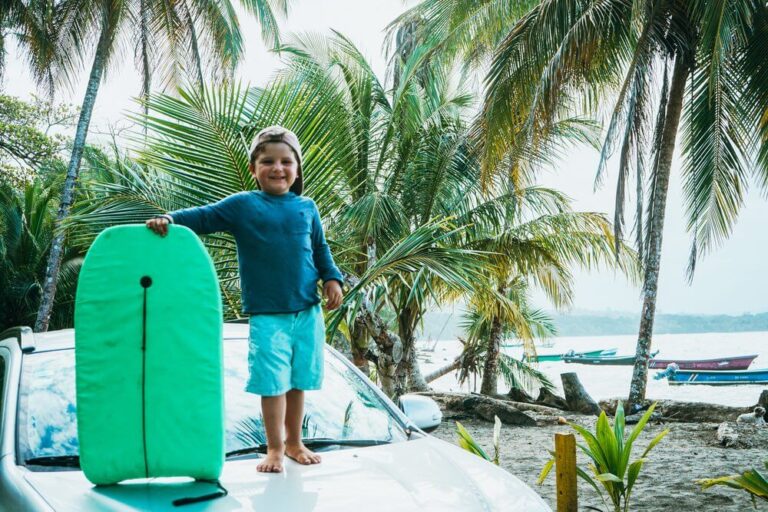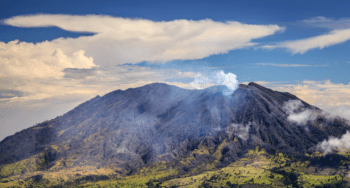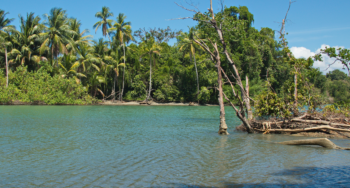Quick Guide to Costa Rica with Kids
Costa Rica with kids works beautifully once you understand the logistics. Manuel Antonio offers flat trails for toddlers, Arenal has adventure activities for elementary-age kids, and Guanacaste beaches provide surf lessons and calm waters. Activities run $3-15 per child. Having a reliable vehicle with car seats (legally required) and A/C makes mountain drives smooth.
Quick Facts:
- 7-8 AM park visits catch active wildlife before crowds
- 4×4 needed for Monteverde; standard cars work coastal routes
- Pack for 60-90°F swings between beaches and mountains
- Green season saves 30-40% versus dry season
Top 5 Destinations:
- Manuel Antonio – Flat trails, guaranteed wildlife, safe swimming
- Arenal – Hanging bridges, hot springs, volcano views
- Tamarindo – Calm waters, surf lessons, full amenities
- Monteverde – Ziplines, cloud forest, teen-friendly adventure
- La Paz Waterfall Gardens – No hiking needed, easy from San José
Match destinations to kids’ ages and stay flexible for afternoon rain showers.
If you need any help with a Costa Rica car rental, contact us now!
Planning a family trip to Costa Rica? Let me share something most travel guides won’t mention: Costa Rica’s diverse landscapes and tropical climate create unique challenges that require more than just standard family vacation planning.
Here’s the good news though. Costa Rica is genuinely one of the world’s most family-friendly destinations once you understand how to navigate its quirks. The country’s “pura vida” culture embraces children, safety standards are high, and you’ve got activities to keep kids engaged whether they’re 3 or 13.
What makes the difference between a stressful family vacation and smooth, memorable experiences? Practical preparation that accounts for everything from sudden weather changes to Costa Rican road conditions. Let’s dig into the insider knowledge that’ll transform your family logistics from potentially chaotic to surprisingly smooth.

What Should You Know About Costa Rica's Family Culture?
Visitors often find themselves pleasantly surprised by how welcomed their children feel here. Costa Rican culture revolves around extended family, and social activities tend to include everyone from babies to grandparents.
Sure, there are adult-only resorts, but generally? Restaurant staff will light up when they see tiny guests. Hotel employees will go out of their way to amuse your kids. It’s not just good service – it’s genuine warmth toward families.
Which Destinations Work Best for Different Ages?
Where Should You Take Toddlers and Preschoolers (Ages 2-5)?
For your youngest travelers, you’ll want destinations with short travel times and lots of visual stimulation. Long hikes? Save those for when they’re older.
Manuel Antonio National Park hits the sweet spot for this age group. The main trails are mostly flat, wildlife sightings happen quickly, and beaches provide backup entertainment when attention spans waver. Your toddlers will spot monkeys, sloths, and iguanas naturally – it’s like a real-life “I Spy” game.
Insider timing tip: Hit Manuel Antonio at 7-8 AM. Animals are most active, crowds haven’t arrived yet, and toddlers still have their best energy. You’ll actually see wildlife instead of just hearing other tourists talking about it.
La Paz Waterfall Gardens near San José offers another perfect option for young children. Elevated walkways mean no difficult hiking, and those massive waterfalls provide constant “wow” moments that hold even the shortest attention spans.
What About Elementary School Kids (Ages 6-10)?
This age group thrives on adventure activities that feel exciting but remain manageable. They can handle longer car rides and actually appreciate when you mix educational components with fun.
The Arenal Volcano region becomes ideal for this age bracket. Kids can grasp the volcano concept, enjoy easier hiking trails, and absolutely love the hot springs. Hanging bridges provide adventure without requiring technical skills, and wildlife spotting becomes an active game they can participate in.
Want to keep elementary-age kids engaged? Give them specific jobs. Make one the “bird spotter” and another the “sloth finder” on nature walks. They need to feel involved, not just entertained.
How Do You Keep Tweens and Teens (Ages 11+) Interested?
Older kids want real adventure and can handle challenging activities. They’re also the first to complain about “boring” nature walks if there’s nothing interesting happening.
This age group gravitates toward active experiences: whitewater rafting on the Sarapiquí River, zipline canopy tours in Monteverde, or surf lessons in Tamarindo. They can also appreciate cultural experiences like coffee plantation tours where they learn about Costa Rica’s economic backbone.
Photography trick for teens: Challenge them to capture wildlife photos for Instagram. Costa Rica’s incredible biodiversity means they’ll get stunning shots that actually impress friends back home. Suddenly, nature walks have purpose.
What Kind of Vehicle Do Families Actually Need?
Which Vehicle Features Are Non-Negotiable?
Air conditioning isn’t just comfort – it’s a necessity for family travel in Costa Rica’s tropical climate. Even during green season, afternoon heat becomes unbearable for children, especially during longer drives.
Child safety seat requirements follow Costa Rican law: children under 12 must use appropriate car seats or booster seats. Vamos provides car seats with advance reservation, eliminating the hassle of traveling with bulky safety equipment. Your first child seat? It’s free.
Space reality check: A family of four with luggage needs more room than you think. Costa Rica’s varied climates mean packing for beach days, mountain weather, and rain protection. Choose vehicles with adequate storage for all that gear accumulation that happens with family travel.
Do You Really Need a 4×4?
The vehicle decision depends heavily on your destination mix and children’s ages.
Standard vehicles work perfectly for families focusing on developed areas: Manuel Antonio, major Guanacaste beaches, San José area attractions, and well-maintained routes. Got young children who require frequent stops? Staying on paved roads reduces travel stress significantly.
4×4 becomes essential for adventure-focused families planning to visit Monteverde, remote beaches, or traveling during green season. The higher seating position also helps with carsickness – something many children experience on Costa Rica’s winding mountain roads.
Why families prefer 4x4s: Better visibility for children looking out windows means fewer “I can’t see anything” complaints during scenic drives.
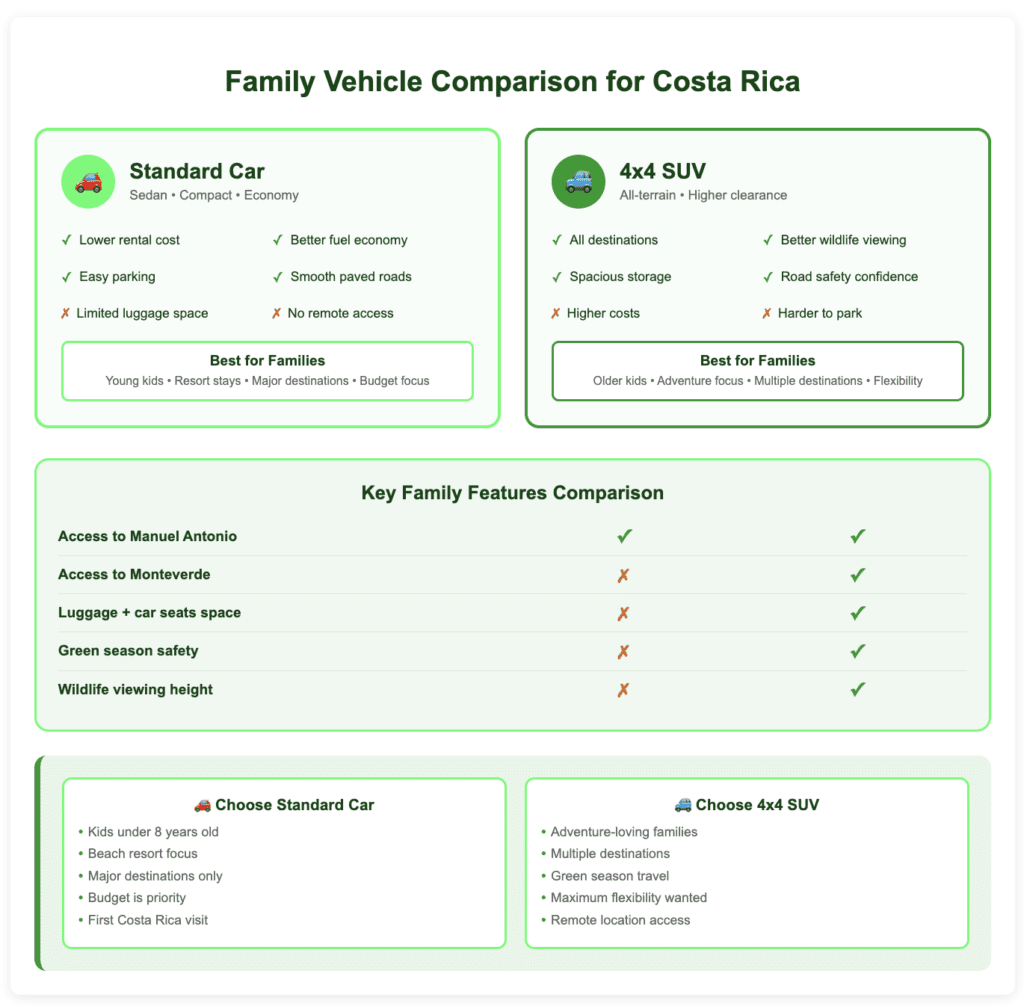
How Do You Keep Kids Healthy and Safe in the Tropics?
Costa Rica’s tropical environment creates specific health considerations that differ from typical vacation planning.
What’s the Real Deal with Sun Protection?
Costa Rica sits close to the equator, making sun exposure intense year-round. Children burn faster than adults expect, even on cloudy days.
Apply SPF 30+ sunscreen 30 minutes before sun exposure, and reapply every 2 hours religiously. Pack sun hats and UV-protective shirts for beach days and outdoor activities. Places like Monteverde? The combination of altitude and equatorial proximity means UV exposure stays high even when temperatures feel cool.
Money-saving tip: Costa Rican pharmacies (farmacias) stock excellent sun protection products, often at better prices than resort shops. Look for brands like Bayer or Isdin – tropical-strength formulations. Though honestly? It’s still cheaper to buy at your local supermarket and pack it.
How Should You Handle Bugs and Bites?
Mosquitoes and other insects become more problematic with children. Kids tend to scratch bites and often have stronger reactions.
Use child-safe insect repellent with picaridin rather than DEET when possible. Long sleeves and pants during dawn and dusk hours provide protection when insects are most active. Pack After Bite or similar anti-itch treatments – you’ll need them.
Make sure your accommodation has screens and keep doors firmly closed at dusk and dawn. No A/C? Put a mosquito net over your child’s bed and direct a fan on them. Keeps off bugs without making it too hot to sleep.
Best activity timing: Insects are least active during midday heat. Plan outdoor activities in heavy bug areas for 11 AM-3 PM.
What About Water and Food Safety?
Costa Rica’s tap water is safe to drink in most tourist areas, but children’s sensitive systems sometimes react to different mineral content. Carry water bottles and refill from reliable sources instead of constantly buying plastic bottles.
Pack familiar snacks for picky eaters. Costa Rican cuisine is generally mild and child-friendly, but having backup options prevents hangry meltdowns during long travel days.
Restaurant hack: Most Costa Rican restaurants offer simple rice and chicken dishes (“pollo con arroz”) that appeal to children who resist trying new foods.
How Do You Pack for Beach, Mountain, and Rainforest in One Trip?
Costa Rica’s diverse microclimates mean you’ll encounter different weather conditions within hours of driving. Your packing strategy needs to account for this.
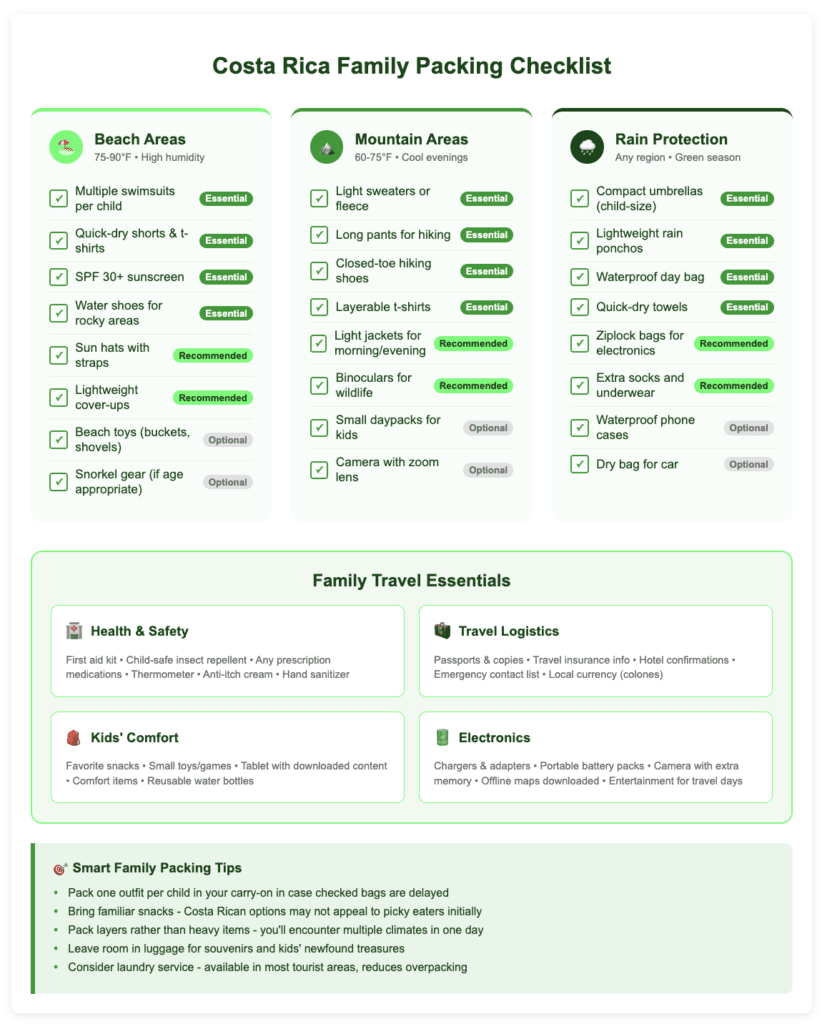
What Works for Each Climate Zone?
Beach areas stay hot and humid year-round. Pack lightweight, quick-dry clothing and extra swimwear. Children go through multiple outfit changes during beach days, especially when they’re alternating between pool and ocean activities.
Mountain destinations like Monteverde require warm layers for morning and evening cool periods. Temperatures can drop to 60°F (15°C) at elevation – you’ll need sweatshirts or light jackets even during dry season.
Central Valley weather stays consistently mild, but afternoon rain showers during green season mean rain protection. Pack compact umbrellas or ponchos that children can manage independently.
Packing reality: Layering beats trying to predict exact weather. Pack t-shirts, light long-sleeves, and one warm layer per child instead of heavy items you might not need.
Which Activity Gear Is Actually Essential?
Water shoes have become essential for Costa Rica family travel. Many beaches have rocky areas, and river activities require foot protection. Choose shoes that dry quickly with good traction on wet surfaces.
Give each child old enough their own day pack for water and snacks. Builds responsibility while ensuring they have necessities during longer excursions.
Gear shopping tip: Don’t overpack activity-specific items. Tourist areas have good outdoor shops where you can buy or rent specialized equipment like snorkeling gear or hiking poles.
Where Should Families Go for the Best Experiences?
Different regions offer distinct advantages for family travel, with some destinations working better for specific age groups and travel styles.
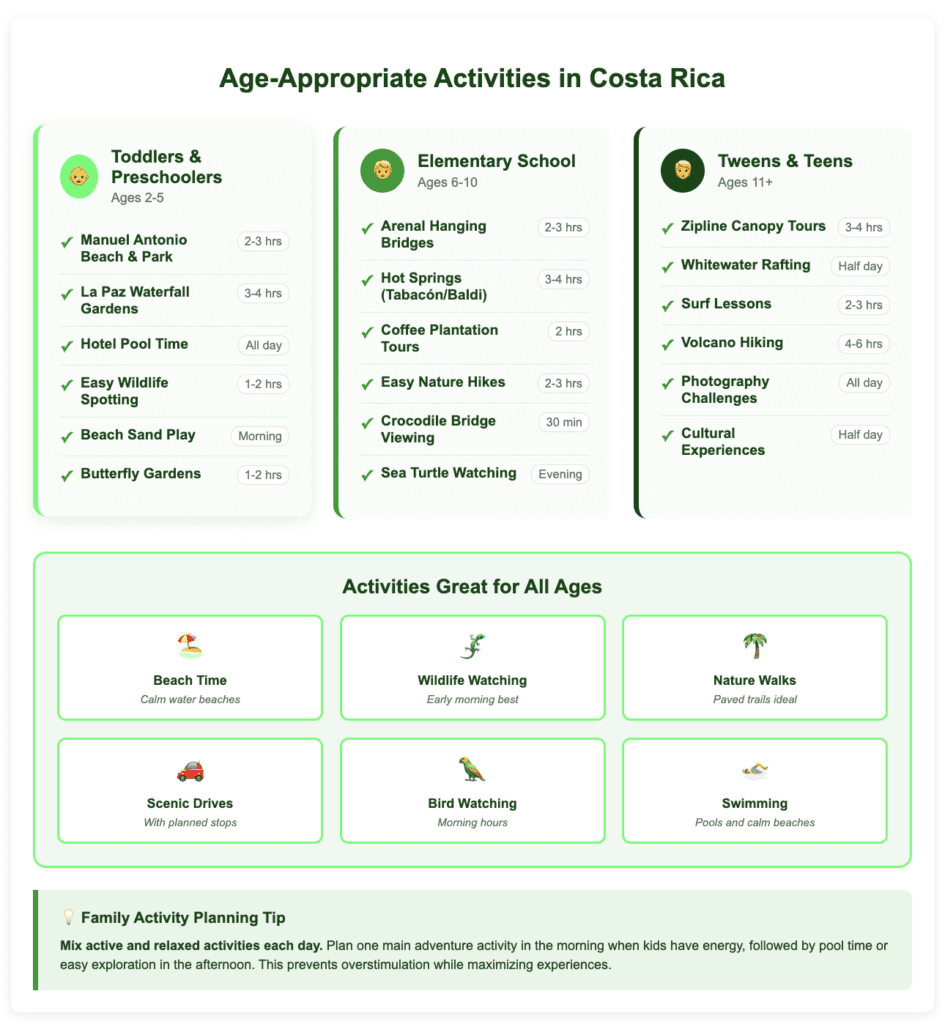
Why Is Manuel Antonio So Popular with Families?
Manuel Antonio remains Costa Rica’s most family-friendly destination for good reason. You’ve got national park wildlife, beautiful beaches, and developed infrastructure creating ideal conditions for family travel.
The park’s main trail system accommodates strollers on paved sections. Families with older children can explore secondary trails for better wildlife viewing. Beach access within the park provides safe swimming with lifeguards during peak hours.
Activity timing secret: Hit the national park at 7-8 AM when wildlife is most active and crowds minimal. Spend midday hours on the beach when park trails become hot and crowded.
What Makes Arenal Perfect for Adventure Families?
Arenal region offers adventure activities scaled for different ages while maintaining family-friendly infrastructure. That dramatic volcano backdrop provides constant visual interest keeping children engaged during drives and activities.
Hanging bridges tours work because everyone can participate regardless of hiking ability. Elevated walkways provide safety while offering canopy-level wildlife viewing opportunities.
Hot springs in the Arenal area create unique experiences for children. Choose family-oriented facilities like Tabacón or Baldi over adult-focused venues. Natural hot pools provide novelty without requiring special skills or equipment.
Package deal secret: Many Arenal adventure activities offer family packages with age-appropriate modifications. Zipline companies often have special shorter lines for younger children while maintaining the excitement factor.
Which Guanacaste Beaches Work Best for Families?
Guanacaste’s developed beach infrastructure makes it ideal for families seeking relaxation over adventure. Beaches like Tamarindo and Playa Conchal offer calm waters, amenities, and easy access.
Tamarindo provides surfing lessons for older children while maintaining calm areas for younger kids. The town infrastructure means easy access to restaurants, shops, and medical facilities if needed.
Ocean safety insight: Guanacaste beaches generally have gentler surf than Pacific beaches further south, making them safer for children learning ocean swimming.
How Do You Handle Long Drives with Kids?
Driving in Costa Rica with children requires different strategies than solo or couple travel, particularly regarding timing and route planning.
What’s the Secret to Managing Drive Times?
Costa Rica’s mountainous terrain means longer drive times than maps suggest. Build in extra time for stops, snacks, and bathroom breaks.
The Tárcoles Bridge (between San José and Manuel Antonio) offers guaranteed crocodile sightings that fascinate children while providing a natural rest break. This bridge stop transforms a potentially tedious drive into an adventure. Just don’t leave your vehicle unattended.
Plan driving during children’s natural rest times when possible. Early morning departures (6-7 AM) work well – children often sleep during the first hour while roads are less congested.
How Do You Prevent Car Sickness on Mountain Roads?
Costa Rica’s winding mountain roads can trigger motion sickness in children who don’t typically experience it. The combination of curves, elevation changes, and tropical heat creates challenging conditions.
Choose routes with fewer elevation changes when possible. The drive to Monteverde, while scenic, involves significant mountain curves that can be problematic for susceptible children.
Prevention strategies that work: Encourage children to look at distant scenery rather than reading or focusing on close objects. Keep windows slightly open for fresh air circulation. Time drives during cooler parts of the day when possible. Antinausea medication is widely available at local pharmacies, but bring familiar brands from home if possible.
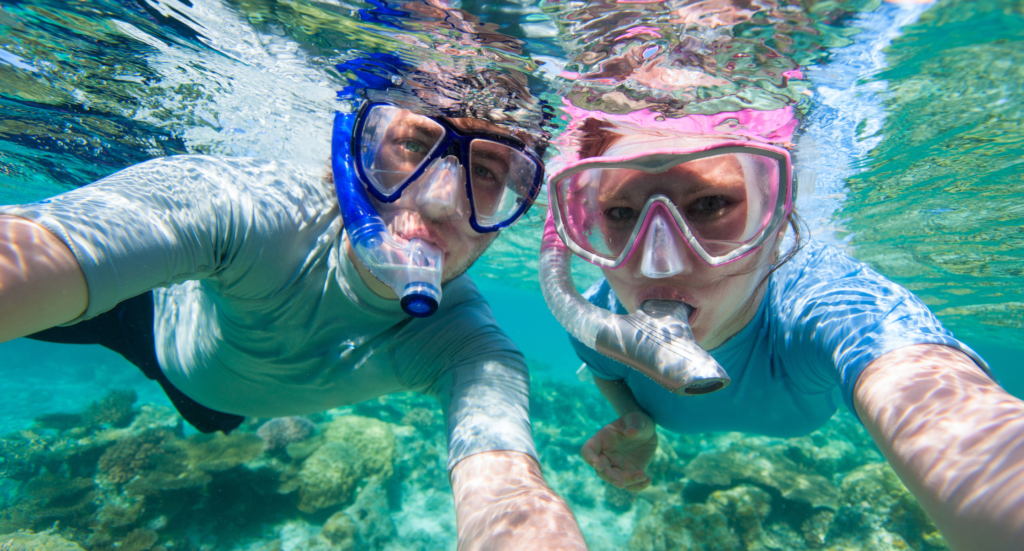
How Can Families Save Money Without Sacrificing Fun?
Family travel in Costa Rica can become expensive quickly. Strategic planning helps manage costs without sacrificing experiences.
Which Accommodation Type Offers Best Value?
Vacation rentals often provide better value for families than hotels, especially for stays longer than 3-4 nights. Kitchen access allows preparing familiar meals for picky eaters while reducing restaurant costs.
Many Costa Rican accommodations offer family rooms or connecting rooms at reasonable rates. Book directly with properties to negotiate family package deals including activities or meals.
All-inclusive insight: Guanacaste resorts can provide good value for families with multiple children. Kid-friendly amenities and meal inclusion offset higher nightly rates.
Where Can You Find Free Activities?
Many of Costa Rica’s best family experiences are free or low-cost. Beach time, wildlife watching, and exploring national parks provide full days of entertainment at minimal cost.
Group tour discounts often apply to families, and many activity providers offer child pricing (typically ages 6-12). Always ask about family packages when booking tours or activities.
Beach secret: Public beaches throughout Costa Rica offer the same wildlife and scenery as private resorts without entrance fees. Places like Playa Conchal and Manuel Antonio’s public beach areas provide excellent family experiences at no cost beyond transportation.
When Should Families Visit Costa Rica?
Timing affects both costs and experience quality when traveling with children.
Why Do Families Love the Dry Season (December-April)?
The dry season provides predictable weather patterns that simplify family planning. Minimal rain means outdoor activities proceed as scheduled, reducing disappointment from cancelled plans.
Road conditions remain optimal during the dry season, making family road trips more comfortable and safe. Dust on unpaved roads can be an issue, but overall travel conditions favor family exploration.
Booking reality: Dry season brings higher prices and more crowds, particularly during North American school holidays. Book accommodations and activities well in advance for peak weeks.
What Are the Hidden Benefits of the Green Season (May-November)?
Green season offers significant cost savings and fewer crowds, making it attractive for budget-conscious families. The landscape becomes lush and vibrant, creating better wildlife viewing conditions.
Rain typically comes in afternoon showers rather than all-day downpours. Morning activities proceed normally. Build flexibility into schedules for weather-related changes.
Afternoon rain advantage: Those showers provide welcome relief from heat and create natural downtime opportunities that children need during active vacations.
Ready to Make Your Family's Costa Rica Adventure Real?
Planning a successful Costa Rica family trip requires balancing ambitious exploration with realistic logistics.
Before you go:
- Reserve appropriate car seats through Vamos to ensure safety compliance and avoid travel hassles
- Plan route timing around your children’s schedules, allowing extra time for stops and meals
- Book family-friendly accommodations with kitchen access or connecting rooms for space and convenience
- Pack for multiple climates using layering strategies rather than heavy, single-purpose items
- Research child pricing for activities and tours to budget accurately for family experiences
Upon arrival:
- Start with easier destinations to help children adjust to Costa Rica’s climate and pace
- Build rest days into ambitious itineraries, especially during the first few days
- Remain flexible with plans while maintaining key experiences that excited your children about the trip
The real magic of family travel: Costa Rica’s greatest gift to traveling families isn’t just incredible wildlife or beautiful beaches. It’s the opportunity to show children that adventure and discovery can happen anywhere when you approach new experiences with curiosity and respect.
Your Costa Rica family adventure becomes the foundation for a lifetime of travel confidence and cultural appreciation. With proper planning and realistic expectations, those challenging logistics fade into background details while shared discoveries create family stories you’ll treasure for years.
Ready to plan your family’s Costa Rica adventure?
Vamos provides the family-friendly vehicles, car seats, and local expertise that transform ambitious family travel dreams into smooth, memorable realities. From ensuring proper child safety equipment to recommending family-appropriate routes, Vamos helps families focus on making memories rather than managing logistics.
The perfect family vacation combines adventure with safety, discovery with comfort, and ambitious exploration with practical planning. Costa Rica delivers all of these – when you know how to navigate its unique challenges and opportunities.
